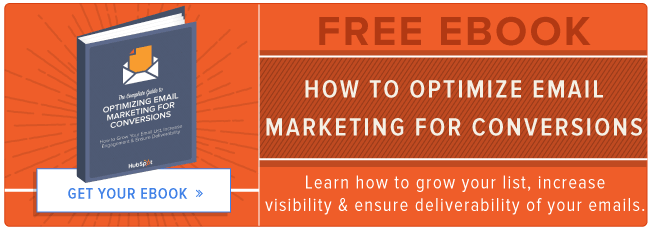 This is the part where I tell you how bleak it is to be an email marketer.
This is the part where I tell you how bleak it is to be an email marketer.
Crowded Inboxes. New ways to filter. Tougher deliverability standards. These are all reminders that anyone who’s sent a marketing email in the last decade doesn’t really need.
We all know the story. Good email marketing is tough and getting tougher — but tough could be just the environment we need to motivate a change.
Email isn’t what it used to be. But isn’t that a good thing?
The most fundamental and important characteristic of the modern web is its ability to evolve. In an outstanding article, The Atlantic’s Alex Madrigal reminds us: Email was a news feed; now we have Twitter. Email was a way to send documents; now we have Dropbox. Email was the primary form of communication online; now we have … well, everything.
But the displacement of these original purposes doesn’t displace email as a whole. Can you imagine if we were all still using Twitter to report out what we had for lunch?
Channels evolve because the way we use them evolves. One necessitates the other. What fascinates me about today’s disdain for email marketing is that we’ve recognized and driven innovation in almost every other communication channel — except email.
Maybe we should shoot the messenger.
More than 100 billion marketing emails are sent per day. And the truth is, today’s 100 billion marketing emails don’t look all that different from yesterday’s 100 billion. Or the 100 billion marketers sent the year before that.
Email is a vehicle. It sends and receives; it edits and links; it is, at the end of the day, a collection of bites and pixels. The problem isn’t email — the problem is that, as the consumer uses of email have evolved, marketing uses of email have stayed the same.
Let’s look for a minute at three major things that have changed about email marketing.
1) 51% of emails are now opened on-the-go.
My colleagues and I have written a lot about making sure your emails resolve properly on mobile devices through responsive email templates and the right font sizes. But what about an email message strategy that also adapts to the email reader on the go?
We know, for instance that people who open email on their phones are far more action-oriented than their desktop counterparts. What about using a personalization engine, like the one found in HubSpot, to automatically alter the content of landing page based on whether the recipient clicked through to it from her phone or desktop? That’s getting warmer.
2) Personalization is everywhere.
While we’re on the topic of personalization, let’s push it a bit further. From customized movie recommendations to tailored Google search, today’s buyers have grown accustomed to media that adapts around their behavior. The first attempt at personalization in email was using a contact database to address someone by their first name in an email body. This was a step forward, but prone to errors — and, in truth, it was more of a clever parlor trick than a true innovation. To innovate on email personalization, we need to consider what would make a meaningful difference for recipients.
We should be using data from all of marketing channels, not just email, to better understand an email recipient’s interests or timetable for purchase. Integrating your marketing channels with a single contact database can help you get that 360-degree-view of a prospect, lead, or customer. Combine that with a good personalization strategy, and you’ll start to get into some interesting space with the way you can tailor email messages.
3) Inboxes are helping recipients sift through their email.
Earlier this month, Twitter announced that it will start employing an algorithm similar to the one found on the Facebook News Feed to surface more relevant content for each user. Gmail has already instituted inbox tabs, and it’s not hard to imagine this sort of assisted filtering extending to other inbox clients in the future.
So the question is: How do you innovate when relegated to a sub-folder? One way is to make sure your subject lines are intriguing and actionable every single time. Beyond that, though, we should also work to understand the mindset people are in when filtering through marketing emails. Do they set marketing emails aside to go through in one fell swoop later? If so, can you make the most of that time and mindset? Google thinks that people browsing marketing emails may behave similarly to people window shopping or flipping through content, and so it has begun to experiment with displaying marketing emails in Pinterest-style boards for browsing.
If inboxes are using these kind of optimizers, marketers should follow suit. Think about the role subject lines and visuals play in your marketing emails. Do some research to find your ideal send time. I don’t mean research industry benchmarks or general guidelines — research the send times that work best specifically for your company’s emails. (HubSpot customers, we just built this in for you). Research your own customers to help determine what kind of content catches their eye when they scan rows of marketing email. See if you can sit with them and observe their behavior when browsing email content.
What we have here is an opportunity for true reinvention.
Almost no one actually thinks that email is dead. In fact, in our hot-off-the-press 2014 State of Inbound Marketing report, 80% of marketers report that email has become a more important lead source over the last six months.
But worst than death is falling prey to a sentiment that email marketing has become stale, and that the only way to “do” email is to approach it in the same way we always have. That’s a fate that does none of us any good. We innovate on content all the time — we build incredibly impressive homepages; we create art out of 6-second videos. Why not email?
Email’s best days are still to come. As Madrigal writes, “Email is actually a tremendous, decentralized, open platform on which new, innovative things can and have been built.”
Simply put: Email isn’t stagnating; the way we use it is. All that’s needed to reawaken its potential is a better understanding of our subscribers’ changing behavior and a few bold ideas to better meet them where they are.
![]()


